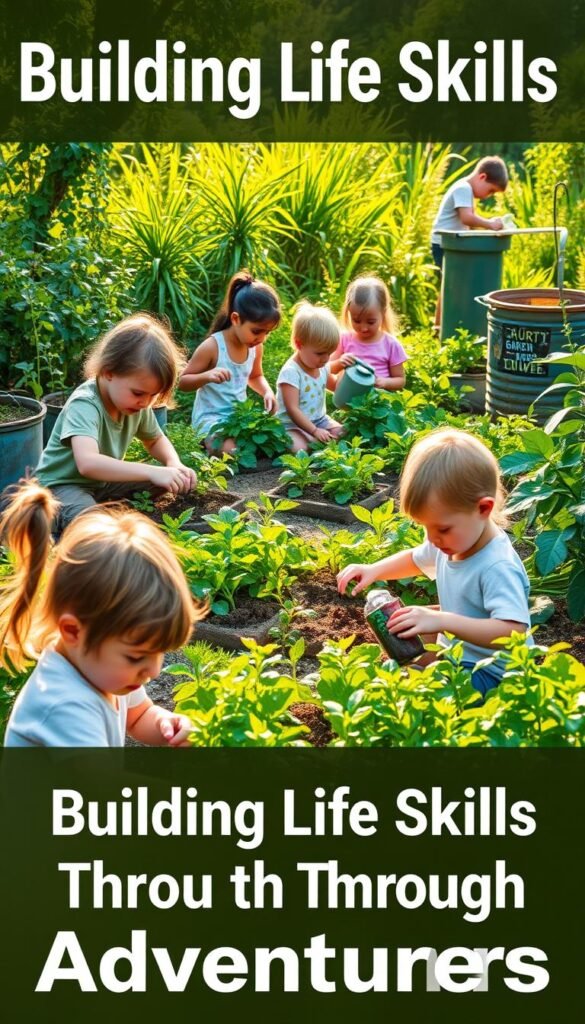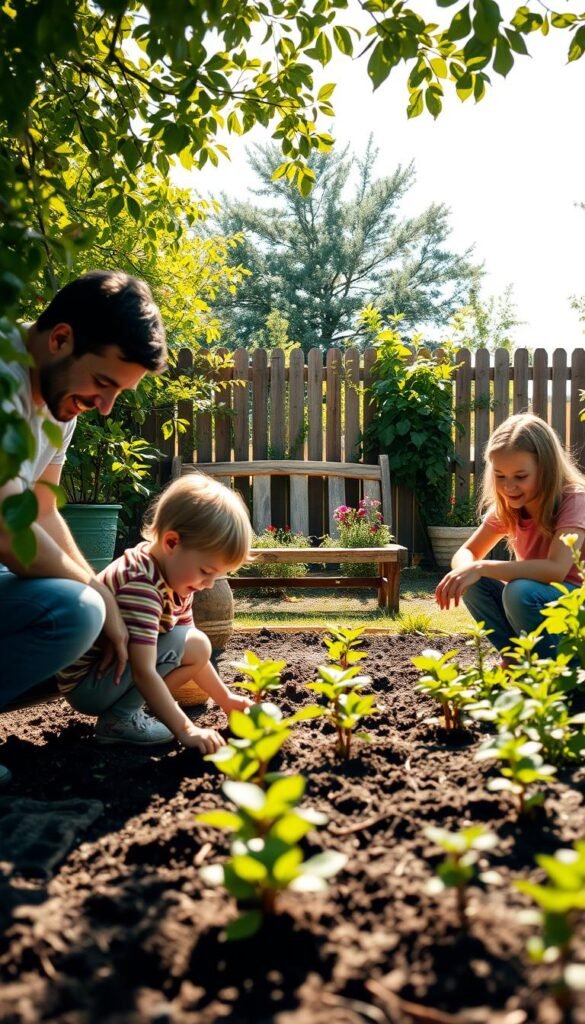What if your backyard could become a vibrant space where family bonds blossom alongside fresh vegetables and colorful flowers? Nurturing plants alongside young ones creates more than just beautiful landscapes – it cultivates essential life lessons that shape character and strengthen relationships.
Research shows caring for living things helps children develop persistence and commitment. Whether measuring sprout growth or mixing compost, these hands-on experiences teach that meaningful results require consistent effort. Age-appropriate tasks – from seed planting for preschoolers to harvest planning for preteens – give everyone purposeful roles.
This shared activity becomes particularly valuable in our fast-paced world. Studies reveal young ones who witness gradual plant development often demonstrate stronger focus in other challenging tasks. Through simple ways to teach patience, you’ll help them understand delayed gratification while creating joyful memories.
Beyond practical skills, tending green spaces together fosters teamwork and mutual appreciation. Each watering session or weeding project becomes a chance to connect meaningfully while nurturing something greater than yourselves. Discover how this timeless practice prepares kids for future challenges through real-world experiences that textbooks can’t replicate.
Getting Started with Family Gardening

Creating a thriving family green space begins with smart preparation and age-appropriate choices. You’ll want to design an environment where curiosity grows naturally while keeping tasks manageable for small helpers.
Preparing Your Garden Space for Success
Start by picking a sunny spot near your water source – little ones lose interest quickly when hauling watering cans long distances. Ensure pathways are wide enough for tiny feet and tools. Raised beds or container gardens work wonders for keeping plants at eye level while protecting delicate roots.
Choosing Kid-Friendly Plants and Tools
Mix instant gratification with delayed rewards. Radishes pop up in 3 weeks, while cherry tomatoes teach waiting skills. Try easy seed-starting projects with sunflower seeds that sprout fast – perfect for short attention spans. Arugula leaves become salad-ready quicker than you can say “harvest time!”
Equip your crew with colorful, child-sized tools. Bright trowels and personalized plant markers turn work into play. Let each family member claim a small plot while collaborating on shared crops like bush beans. This balance builds responsibility through individual care and teamwork during garden activities.
Gardening With Kids: Teaching Responsibility and Patience
Watch young faces light up when a sprout emerges from soil they nurtured. This magical moment holds powerful lessons that shape character development. Nature’s timeline becomes the ultimate instructor, showing that dedication yields delicious rewards.
Rooting Commitment in Daily Care
Carrots teach better than any lecture. Those orange roots demand 70+ days of attention before revealing their crunchy sweetness. Your little ones will discover that responsibility means showing up daily – even when results aren’t immediate.
Track progress together using a growth chart. Measure leaf expansion weekly. Celebrate tiny victories like first blossoms. These rituals build understanding that meaningful achievements unfold gradually.
Seeds of Delayed Satisfaction
Buried beans become living science experiments. Kids witness how consistent watering and sunlight transform hard seeds into climbing vines. They’ll grasp delayed gratification when harvesting peas months after planting.
Create anticipation with a harvest calendar. Mark expected ripening dates for different crops. This visual aid helps children connect today’s efforts with tomorrow’s snacks. Those waiting weeks make fresh strawberries taste sweeter!
Through these earthy adventures, young growers internalize vital truths. They’ll carry the knowledge that patience isn’t passive waiting – it’s active nurturing. And that’s a life skill bearing fruit far beyond garden gates.
Fun and Engaging Gardening Activities for Children

Turn your outdoor space into a living classroom where kids discover science through dirt-covered hands and wide-eyed wonder. Even small green areas become laboratories for exploration when you frame activities as adventures rather than chores.
Interactive Projects to Spark Curiosity
Transform routine tasks into treasure hunts. Create a nature bingo card with items like “three-leaf clover” or “smooth rock.” Young explorers will sharpen observation skills while racing to complete rows. For tactile learners, set up texture stations comparing potting soil to compost.
Whip out magnifying glasses for bug investigations. Chart findings in a garden detective journal using crayon rubbings of bark and leaves. Measure beanstalk growth weekly – those numbers become math lessons in disguise!
Design themed planting zones that double as snack stations. A pizza patch with basil and cherry tomatoes teaches crop cycles through meals. Rainbow plots with purple carrots and yellow squash make color theory delicious. These playful activities encourage kids to connect with nature while absorbing core concepts.
Mix sensory play with quiet moments. Have children close their eyes to identify herbs by scent or listen for specific bird calls. You’ll nurture calm focus alongside budding botanists – all through dirt, discovery, and delight.
Building Life Skills Through Garden Adventures

Your family’s outdoor plot becomes more than dirt and seeds—it’s a training ground for essential abilities that textbooks can’t provide. Through collaborative tasks and natural challenges, young minds develop life skills that translate to everyday success.
Growing Stronger Together
Teamwork blooms when families strategize over plant placement or troubleshoot aphid invasions. Children learn negotiation by debating which veggies to grow, while shared watering schedules teach accountability. These interactions build communication muscles stronger than any pumpkin vine!
Nature’s Classroom of Persistence
From seed to harvest, plants demand steady care. Your crew discovers that growth happens gradually—radish sprouts don’t rush, and tomato fruits won’t be rushed. This rhythm teaches patience better than any timer or app.
| Skill | Classroom Approach | Garden Approach |
|---|---|---|
| Problem-Solving | Hypothetical scenarios | Real pest invasions |
| Decision-Making | Multiple-choice tests | Crop selection debates |
| Collaboration | Group projects | Compost team rotations |
Through these earthy experiences, children learn resilience when storms damage crops and creativity when repurposing fallen leaves. The magic of growth and learning unfolds naturally, proving that the best education often happens in muddy boots.
Encouraging Mindfulness and Connection with Nature

Imagine a place where rustling leaves replace screen time buzzes. Your green space becomes a sanctuary where young minds discover stillness through nature’s rhythms. Studies reveal that outdoor time reduces cortisol levels by up to 15% in children, making soil under fingernails the new stress relief.
Sensory Garden Experiences for Calm and Focus
Crunchy lavender stems release calming scents when brushed. Fuzzy lamb’s ear leaves invite gentle touches. These textured experiences anchor children in the present moment. Encourage them to name five distinct sounds – buzzing pollinators count as bonus points!
Create scent trails with mint and lemon balm. Watch attention sharpen as little noses identify herbs blindfolded. A 2023 University of Illinois study found scent-based activities improve focus duration by 23% in elementary students.
Design touch-and-feel stations with varied surfaces. Smooth stones contrast with rough bark chips. Velvety pansy petals surprise fingertips. This tactile play builds sense awareness while teaching descriptive language naturally.
End each session with quiet observation time. Have your crew sit still for two minutes, noticing wind patterns or ant highways. These micro-meditations cultivate emotional regulation skills that bloom long after leaving the garden bed.
Overcoming Common Gardening Challenges with Kids

Even the greenest thumbs face hurdles when nurturing plants alongside young helpers. Smart planning turns obstacles into opportunities for growth while keeping the experience positive.
Balancing Time and Responsibilities
Set clear weekly routines that fit your family’s rhythm. Saturday mornings might become dedicated planting work, while Wednesday afternoons focus on quick weeding. Rotate tasks so no one feels stuck with boring jobs.
Create a visual calendar showing each member’s responsibility. Color-code watering days and harvest checkpoints. This system helps children see how their efforts contribute to shared success without overwhelming schedules.
Staying Motivated Through Setbacks
When slugs devour lettuce or storms flatten sunflowers, frame these moments as detective games. Ask: “What clues tell us what went wrong?” Celebrate creative solutions more than perfect results.
| Challenge | Solution | Skill Developed |
|---|---|---|
| Forgotten watering days | Set phone reminders together | Accountability |
| Slow-growing plants | Track micro-changes in journals | Observation |
| Pest invasions | Research natural repellents | Problem-solving |
Keep energy high with progress photos and taste tests. Those first bitter kale leaves? They’ll savor them more knowing they grew it. Every struggle becomes part of your family’s growth story.
Creative Ideas for Seasonal Family Gardening Projects
Transform your outdoor space into a year-round learning lab where plants become teachers and dirt doubles as art supplies. Seasonal projects keep your crew engaged through changing weather while revealing nature’s cyclical wonders.
Small Vegetable Gardens and Easy Crops
Begin with quick-growing veggies that deliver fast wins. Snap peas climb trellises in weeks, while rainbow chard adds color to dinner plates. Carrot seeds buried in loose soil become crunchy treasures by midsummer. Rotate watering duties to show how consistent care leads to juicy tomatoes.
Create themed beds like a “salsa garden” with peppers and cilantro. Little hands love pressing seeds into warm earth and marking rows with painted rocks. These edible projects make harvesting feel like a treasure hunt with delicious rewards.
Pollinator-Friendly Flower Beds and Herb Gardens
Design buzzing habitats with native flowers like coneflowers and milkweed. Track visiting butterflies on a chart – monarch sightings earn extra excitement! Add fragrant herbs like basil and thyme that thrive with minimal care.
Turn weeding into a game by hunting “plant invaders” before they spread. Your family will adore brushing mint leaves to release fresh scents during evening garden walks. These vibrant spaces teach ecosystem balance while creating living bouquets.
Embracing Garden Magic and Life Lessons
The true harvest of a family garden isn’t measured in vegetables but in strengthened bonds and life skills that flourish season after season. As young helpers witness seeds pushing through soil, they grasp nature’s quiet truth—meaningful growth requires steady effort and trust in the process.
These earthy experiences become invisible classrooms where values like perseverance take root. Studies show children who nurture plants often apply the same care to school projects and friendships.
Your family’s shared victories—from first sprouts to juicy tomatoes—forge connections deeper than any screen time could offer. Those muddy afternoons transform into lifelong memories where laughter mixes with life lessons.
Through this green journey, you’re not just growing flowers or veggies. You’re cultivating resilient humans who understand that beautiful outcomes stem from small, daily acts of patience and attention.






